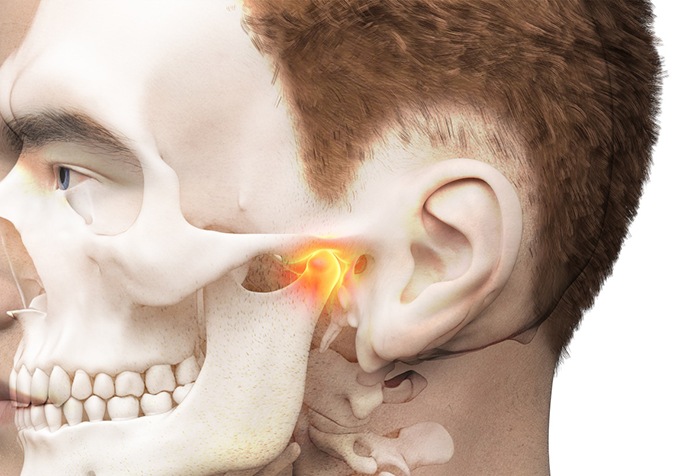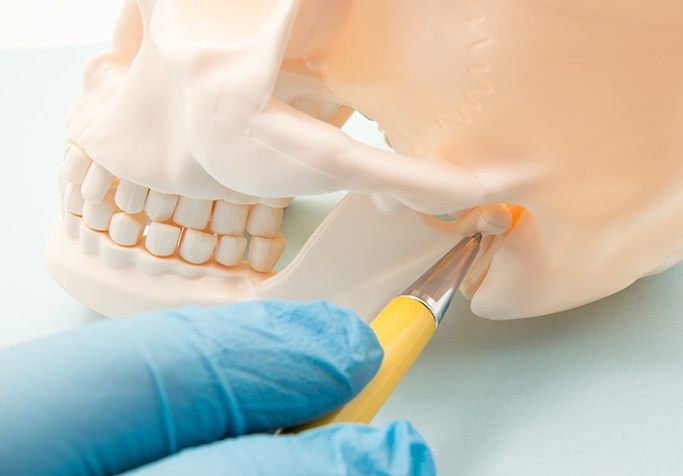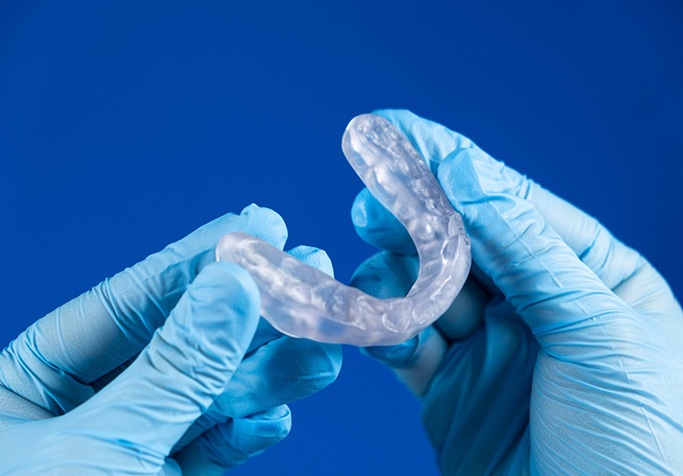TMJ Treatment – Plainview, NY
Finally, a Solution for Chronic Jaw Pain

The hinges in front of your ears are actually called the temporomandibular joint, or TMJ, and they are what allow your jaw to move fluidly whenever you eat, speak, laugh, or yawn. Like other joints in the body, it can often fall victim to strain or injury, leading to what is called TMD, or temporomandibular joint disorder. This can bring on symptoms like a stiff and painful jaw, migraine headaches, earaches, and even unconscious teeth grinding. Fortunately, the team at Meadowbrook Dentistry in Plainview is ready to help patients find a solution for chronic jaw pain. If you believe you have TMD, contact us today to schedule a consultation.
Why Choose Meadowbrook Dentistry for TMJ Treatment?
- Targeted Treatment Using Advanced Technology
- Oral Appliances Designed Using Digital Impressions
- Dentists Dedicated to Ending Your Discomfort
What Is TMJ Disorder?

TMJ disorder is also known as TMJ dysfunction or simply TMD. It can refer to any number of problems that affect how the jaw joint and the surrounding tissues function. When something goes awry with this delicate system, it can result in symptoms that affect your ability to chew food, laugh, speak, yawn, and sneeze with ease.
TMD can be caused by a number of different factors, such as overuse of the jaw joint, chronic stress, a misaligned bite, and more.
Symptoms of TMJ Disorder

One of the most common symptoms of TMD is jaw pain. However, that is just the tip of the iceberg. This condition has been known to cause dozens of different problems, including:
- The sensation of lockjaw
- Difficulty chewing
- Clicking and popping during movements of the jaw
- Earaches and ringing in the ears
- Neck aches and back pain
- Headaches and migraines
- Pain behind the eyes
- Limited movement of the mouth
Types of TMJ Treatment

There is no one-size-fits-all treatment for TMD. When you come in for your appointment, we will take some X-rays, assess your oral health, ask about your symptoms, and then use that information to recommend your next steps. The best solution for you will depend on the specific cause of your disorder, which could be anything from muscle tension to a serious dental problem. Here are a couple examples of therapies that are often effective for relieving TMD pain:
Occlusal Splint

An occlusal splint is a custom-made oral appliance that is designed to hold your jaw in a position where it and the surrounding muscles can relax. Training your jaw to stay in a neutral position can allow your tissues to heal and provide a long-term reduction of TMD pain.
Equilibration/Occlusal Adjustment

Often, TMD is caused by small imperfections in the way the upper and lower teeth fit together. We can address such issues by carefully altering the shape of your teeth so they work more harmoniously with one another. We might also have to adjust some of your restorations or replace them altogether.
TMJ Treatment FAQs

If you have been struggling with persistent jaw pain and related symptoms, the Meadowbrook Dentistry team in Plainview is ready to help you. Before you book a consultation, however, you may be eager to learn more about TMJ treatment and what it involves. Below, you will find answers to some common questions about this service. If your specific questions are not mentioned here, reach out to us directly. We are eager to speak with you!
Can TMD Be Cured Permanently?
For many people, their TMD symptoms come and go over the course of several years. Their pain may seem to resolve on its own for a while, but then it comes back full force. This often happens because the root cause of the problem is not addressed.
Our team strives to provide long-lasting TMJ pain relief by pinpointing the cause of the problem and addressing it accordingly. For example, equilibration can adjust your bite in order to permanently reduce stress on your jaw joint, whereas an occlusal splint can help overworked muscles to relax.
Of course, there is no guarantee that we can provide permanent relief. TMD is a complex condition, and new injuries or stresses to your jaw could cause your symptoms to recur in the future.
Can TMJ Be Fixed with Braces or Invisalign?
In some cases, TMD is the result of a misaligned bite. Invisalign is often capable of correcting an overbite, underbite, cross bite, or open bite. As a result, there is less stress on the TMJ and a greatly reduced risk of TMD symptoms.
Again, though, TMD can be complex. Orthodontic treatment is not suitable for everyone who suffers from it. Our team will need to thoroughly evaluate your case before we can make any recommendations.
Is TMJ Treatment Safe?
TMJ treatment is generally considered to be very safe. As long as it is performed by a qualified professional, there is very little risk that something will go seriously wrong.
Of course, some forms of TMJ treatment carry more risk than others. For example, if we need to refer you to a specialist for surgery, the doctor performing your procedure will be sure to inform you of all the potential risks and rewards involved in your treatment plan.
How Long Does TMJ Treatment Take?
The duration of your treatment will depend on which type of TMJ therapy you undergo. If you need Invisalign, it may be several months to a year or longer before you achieve optimum results. With an occlusal splint, you may notice improvements within a few weeks of starting to use your appliance. Many people who undergo equilibration experience results within a week or so. While you are waiting for your treatment to take effect, we may recommend that you use at-home pain remedies, such as massages, exercises, and dietary modifications.

